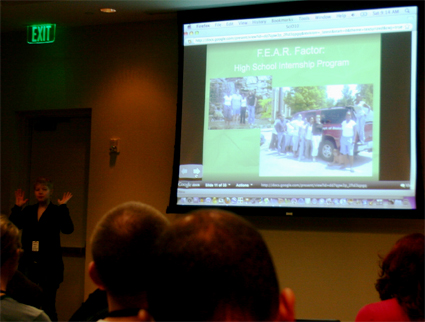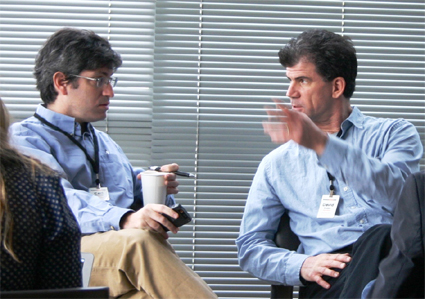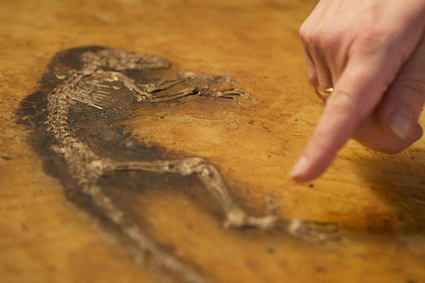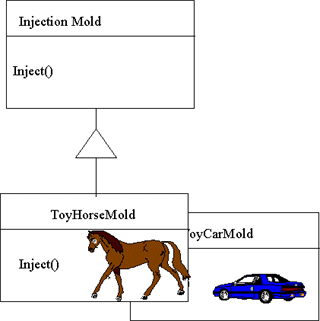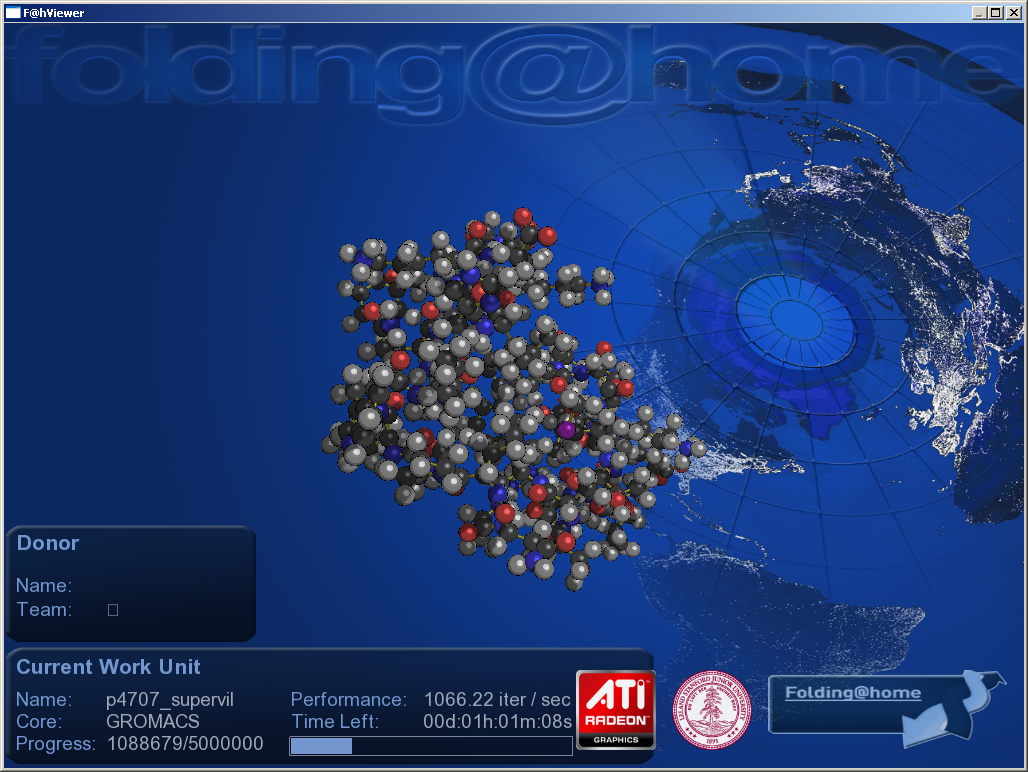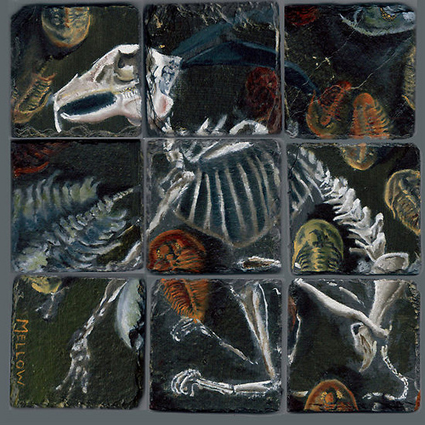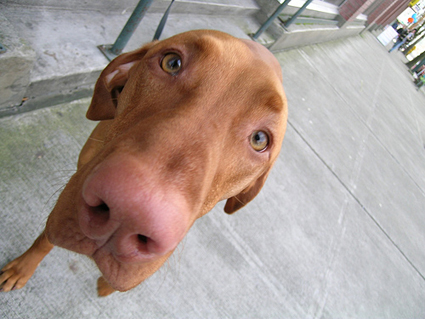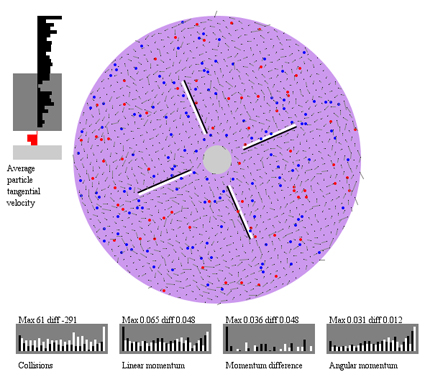This last weekend I burned several month’s worth of Science Friday and This Week in Science episodes to CDs for the ride and made my yearly trip to the Sigma Xi conference center in Durham North Carolina to spend a couple days being overwhelmed with fantastic resources, ideas, and projects in the realm of online science.
This year I was blown away by the number of big-name science popularizers, authors, and bloggers who were able to attend. Including Darlene Cavalier, Kirsten Sanford, Chris Mooney, Carl Zimmer, Nate Silver, and many many more.
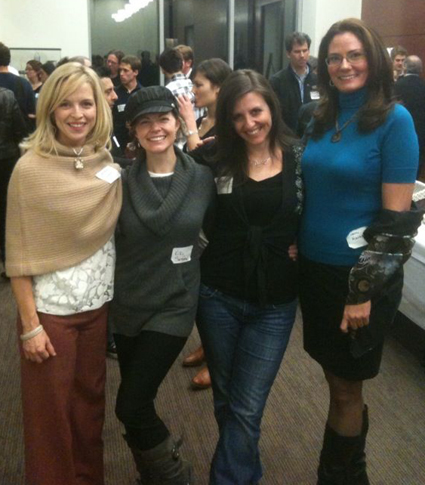
Darlene Cavalier, Dr. Kiki Sandford, Rebecca Skloot, Joanne Manaster at Science Online 2010
Credit: Science Cheerleader
I’ll be posting summaries and thoughts on all the sessions I attended this year throughout the rest of the day. Thanks so much to Bora Zivkovic, Anto Zuiker, and Blog Together for once again organizing such an inspiring and energizing immersion into the world of online science for community-building and activism.
Previous Science Online Coverage 2009, 2008, and 2007
Casting a Wider Net: Promoting Gender and Ethnic Diversity in STEM
Dr. Anne Jefferson of Highly Allochthonous blog headed up this session to “Identify successful online and offline programs, and their commonalities, for recruiting diverse participants into STEM activities” and to “Draft a set of recommendations for individuals, employers, and STEM organizations for supporting women and minority scientists and science students through social media;” with the term “diversity” referring to a diversity of gender, ethnicity, disability, sexuality, employment sector, geography, age, philosophy, or socio-economic status.
Jefferson presented a great deal of survey data she and her peers had conducted soliciting opinions on the effectiveness of blogs supporting women in science, which found that students and academics felt reading these blogs made their personal experiences feel more normal, inspired an interest in academia over industry, and provided a feeling of connection within the field and with other women scientists; however, the same study found women in government and industry held a neutral or even negative perspective of such blogs for reasons at which we may only speculate.
Lyndell Bade presented in lieu of DNLee of Urban Science Adventures blog on their efforts with NSF’s GK-12 Program (couldn’t find a link to specific program). This inspiring program focused on ecology and evolution, with summer research opportunities and high school internships, she described how girls in the program went from being afraid of even touching birds to naming and caring for them. She also mentioned how the group of students went from being segregated to integrated over the course of the project and came up with the name “Future Ecologists As Researchers (F.E.A.R.)” for their group.
Evelyn Lynge presented on the American Association of University Women (AAUW), an organization I of which I was unaware, but has a long illustrious history following its foundation in 1881 by 17 women with college degrees, which includes raising money for Marie Curie to buy radium, lobbying for women’s suffrage in 1920, support of the 1964 Civil Rights act, and, most recently, efforts in passage of the Lilly Ledbetter Fair Pay Act of 2009.
Suzanne Franks presented on fostering a community, with some deep insights into the process such as knowing your history, using creativity to overcome monetary constraints (like starting a support group with chips, soda, and a volleyball net), and building connections outside of the community through space and time (WEPAN, mentornet, Chronicle Forums, and the ADVANCE Portal). She also presented a list of her favorite books on the subject, highly recommending Diann Jordan’s “Sisters in Science: Conversations with Black Women Scientists on Race, Gender, and Their Passion for Science,” while Vicky and I also added Jane Margolis’ “Stuck in the Shallow End: Education, Race, and Computing” as highly pertinent to our own efforts.
A Disconnect to Consider
Memes of note from the discussion included the hypothesis that the Christian Clerical origins of many sciences contributes to the exclusion of women, a woman working in industry noting that the majority of her coworkers were women (mine too) and wondered if the issue of a lack of diversity wasn’t worse in academia, and taking advantage of the fact that online communities may be fashioned without ethnicities, genders, or other differentiating traits. This last idea led to another commenter raising the question of whether it was more important for online communities to be diversity-neutral and stand on the merit of ideas alone, or if it was better for people to know the gender, race, etc of participants so there may be role-models with which others may identify.
Is a lack of identity in an online community “a bug or a feature?” was the question one participant raised. One problem with online anonymity, it was countered, was that it allowed people to associate whatever stereotype the reader had with the speaker. An example given was a blogger who regularly wrote about her medical doctor, who was identified as a woman, but whom commenters on the blog continually referred to as “he”. Another point was raised that, when a gender/ethnicity identity is revealed, critics may use it to reinforce their stereotypes, as when it is discovered that someone is a women, a male with gender-bias might think, “That’s why her ideas are wrong.” This reminded me of this classic Non-Sequitur Comic Strip illustrating this same idea.
At the same time, it must also be taken into consideration that the minorities within a field or at an organization may not appreciate being foisted into a role-model status, and that university departments should be sensitive to whether they are trying too hard to stress the presence of minorities within their organization.
Random Personal Thoughts:
Vicky has covered our efforts to bring our neighborhood kids into computer literacy with the incentive of giving them laptops (See her posts for classes 1, 2, 3, 4, 5, 6, 7, 8, 9, 10, 11, 12), and a delicate objective within that is to introduce them to our geek culture while encouraging the students to express their own unique perspectives to online mediums. It’s challenging for me to consider that I don’t ever consciously think about the fact that I am culturally identified as Caucasian, but our neighborhood kids do continually make reference to the fact that they are African American, and I can cite many instances of them self-stereotyping, as when one student criticized another for using a “white-people voice” when talking to us. Ethnicity does play a large role in self-identification for minorities, and role-models who buck the stereotypes are crucial in challenging everyone’s assumptions.
“Know Your History”
I work in the Information Services Division of the Coast Guard’s Aviation Logistics Center, where I have noticed that more than 50 percent of the programmers over the age of 40 are women. Under 40, the percentage of women programmers drops dramatically. This is because, historically, computing was women’s work. The ENIAC Programmers were women and one of computer science’s programming pioneers, Rear Admiral Grace Hopper, was a woman. Somewhere along the way things changed, women began to perceive computing as a “geek” thing, unattractive as a profession (despite the fact that there is nothing more attractive than a geeky lady).
While the geek factor probably plays a part in the lack of African American representation in computing, in our local the poverty factor also presents a barrier to students going into computer science. An African American child in Elizabeth City North Carolina wanting to go into computer science, despite a personal interest in computing and social support in the form of scholarships and student loans, would still be facing an imposing cultural barrier: they have grown up in households without computers. This lack of resources comes up again and again during different conference sessions, and is a major obstruction to breaking down the barriers to academia for people of lower socio-economic status.
Additional:
See the wiki for this session, which has links to additional resources.
You can see a PDF of my raw notes from this session here.
Rebooting Science Journalism in the Age of the Web
Four prominent journalists, Ed Yong, Carl Zimmer, John Timmer, and David Dobbs, shared their views and opinions on the state of the field in this panel discussion. I was glad to have Yong announce that the “blogger versus journalist” debate was put to sleep four years ago (waaaaay back in Science Online 2007) and that everyone was mostly in agreement that journalism is now defined as a set of values, such as commitment to accuracy and fact-checking, rather than just a paid profession.
Timmer brought up the advantage large newspapers have in bringing science to non-scientists, as most people read the NYT’s for general articles, and are introduced to science news incidentally through the periodical. In contrast, Ars Technica’s readers come to the site because they are looking specifically for science and technology news. Bora made a very insightful observation about push vs pull media, where blogs are the pull and newspapers are the push because the “audience is already there and can’t escape.”
Dobbs’ talked about his experience writing lengthy, well-researched articles, the very satisfying kind I love to read in the New Yorker, and how such articles are impossible without funding. With New Scientist gone to a metered system, the Wall Street Journal gone subscription-only, and now the New York Times apparently about to go metered, for-profit support was in question, leading Dobbs to speculate on whether fellowships or other means of supporting the practice would emerge.
Zimmer, who has a foot in MSM and the blogmos, talked about how, after the NYT’s passed on it, his posting videos of duck sex with artificial duck vaginas went viral. This reminded me of the fact that my all-time greatest hit on flickr is a picture titled “Elephant Clitoris, Lion Penis, and Ostrich Penis,” which makes me wonder how many of Zimmer’s hits were people searching for something else.
Debate Over Futurity.org
After someone solicited their opinions on this website, which, like EurekAlert and PhysOrg, publishes raw University press releases in a pretty, newspaperish format, the panelists were in agreement that they thought the site was misleading and damaging to science news, as there was no journalist to fact-check the Universities’ claims and solicit the perspectives of other scientists. When a representative of Futurity in the audience objected to the criticisms, an interesting debate broke out about what constitutes “news” and proper “fact checking.” One audience member said she never trusted anything written about science from any source until she got to read the research paper herself, while a writer from the New Yorker argued that was impossible and that journalistic “filters” were needed to break science news down for the layperson.
My own perspective on this debate, as someone who links to these sites regularly, is that I don’t see much change between the press releases and the MSM article publications, except that the MSM provides much more background and context. As for the fact-checking part of the issue, regular readers of the press-release sites know that, if other scientists object to another researcher’s claims, they will release their own press release debunking it. Whenever I link to a story on this blog in my daily links, I always make sure to run objections and counter-findings of other researchers.
Besides, it’s not like the MSM does the best job of vetting stories anyways. Bora brought up the story of Ida, the missing link, as a great example of a story that inspired the public, even if they didn’t know much about the significance of the fossil; however, it could be argued that this story was an example of the MSM publishing the claims of researchers unquestioningly, as counter-research claimed Ida was a dead-end branch on the evolutionary tree, not a human ancestor. Healthy debate and conflicting research is part of the excitement of science, and I do see this in the chains of press-releases Universities put out, especially research countering another University’s findings.
Additional:
See the wiki for this session, which has links to additional resources.
You can see a PDF of my raw notes from this session here.
Shakespeare wasn’t a semantic web guy
One of the headaches we have come to accept with the anarchic REST Architecture of the World Wide Web is that a link we post to an image, web page, or other resource online today may go dead a month from now. This could happen for a variety of reasons, like the host going down, a company deciding to charge for the content, or the link changing domains. As a result, looking at old blog posts, we see broken images, “content no longer available” messages for embedded videos, and “page cannot be found” messages in response to our onclicks.
What is an inconvenience for web content authors is a much more serious issue for researchers who publish online. What happens to a paper that links to a bioinformatics dataset hosted at another server that goes dead? An anarchic architecture is fantastic for online freedom of expression, but it’s a serious flaw when trying to ensure academic integrity.
Super-mega-kudos to Dr. Jonathan Rees for giving a talk on what is a highly-technical and obscure problem in online research and citations, a talk that less than a dozen people attended and less than half a dozen were able to sit all the way through, but concerned a fascinating problem in computer science that affects everyone who attended the conference.
The solution Dr. Rees advocates involves the computer science principle of introducing a level of indirection to provide a buffer between software components subject to change. In the case of linking to online resources, we are seeking a level of indirection between the source and the referrer to insulate the reference list from the possibility of the link changing or the existence of many different links for the same resource.
The Shared Names Project seeks to provide this level of indirection with a database of links that provide a single connection to a citation that can change its reference if the WWW link to the reference changes. For instance, instead of linking to “http://www.data.gov” directly, researchers would create a “http://sharedname.org/unique_key” link that redirects to data.gov to post in their papers and posts. This way, if data.gov becomes “http://www.info.gov”, only the sharedname unique_key pointer would need to change.
The problem with this level of indirection, despite affording us some stability, is that we are implementing what, to my mind, is a maintenance nightmare. In a programming environment, I try to have total control over all aspects of my program. As Dr. Rees himself asks, whose responsibility it is to manage the database of links? Publishers cannot be responsible for notifying every url-redirecting service, like TinyUrl, that their link has changed, and a community of people using the database of links will cause redundancy and conflicts.
As much as I appreciate Dr. Rees bringing attention to what is an important problem in Computer Science, I can’t see SharedNames as a practical solution.
Few people realize that WWW was just one of many possible strategies for linking everything together. Ted Nelson envisioned an internet where there was only one instance of every object online, and we would all use the same link to it, allowing content providers to control the use of their objects and bring additional stability to the internet. Unfortunately, because we didn’t go with Ted Nelson’s vision of what a URI should be, if we want to maintain the integrity of our references online, we have no choice but to make a redundant copy whenever possible and assume responsibility for maintaining it ourselves. Dr. Rees did mention the fact that data cannot be copyrighted under United States law, this means that researchers in bioinformatics do have the option of downloading the data and posting it to a server with more stability, assuming the storage size is manageable and the resources are available.
Additional:
See the wiki for this session, which has links to additional resources.
You can see a PDF of my raw notes from this session here.
Citizen Science and Students
Bioblitzes are 24-hour volunteer efforts to count and catalogue every life form appearing in a location from sunrise of day one to sunrise of day two. Every year the Audubon Society holds a Christmas Bird Count every year, where participants count the different species of birds that appear in their backyards. iNaturalist brings together a community of people to catalogue the species they see with GPS coordinates and pictures verifying them.
These are all examples of citizen science, described as “any study or project that involves the public and collaboration with a University or non-profit organization.” Sandra Porter, Tara Richerson, and Antony Williams hosted this session to discuss methods of bringing scientists and volunteers together.
Scientists on these projects need to be concerned with data quality, consistent collection, and record keeping, while teachers looking for projects for their students voiced their need to meet educational standards, have the project complete before students graduate, and have the students get additional benefits, such as something to put on a CV or have their name put on some of the data. Projects need to be appropriate to student grade levels, like a project for Trinity High School, where students peformed DNA barcoding on street vendor food among other things.
A Few Citizen Science Resources:
On the ride back to EC, Vicky and I heard about a Google Android app What’s Invasive, which allows users to upload photos of invasive species they find with coordinates to help inform National Park Service rangers of where to focus their efforts.
Additional:
See the wiki for this session, which has links to additional resources.
You can see a PDF of my raw notes from this session here.
Government 2.0
When the Office of Science and Technology Policy held an online forum about how to implement open access policies for research conducted by federal agencies, I leapt at the chance to broadcast my opinion to power; unfortunately, few others chose to do the same. I thought for certain that the slashdot crowd would jump at the chance to participate in a forum that wisely used the same crowd-moderation format as their nerd news site, but the link suggestion got no love.
Anil Dash works with ExpertLabs the organization enabling the government to solicit feedback from its citizens, and he wants to know why, in a packed room of attendees, only two people responded to the OSTP. There were several hypotheses, but the reason that made the most sense was that no one had even heard about the opportunity.
Why not? Why didn’t Slashdot carry the story? Why did Science Blogs only produce one quick link covering this remarkable opportunity (Christina K. Pikas was also the only other person in the room to respond to the OSTP’s request)? There’s also only one link to data.gov, a resource I would expect scientists to be falling over each other to poke, prod, and peer review, but there’s absolutely nothing coming from the science blogs on this.
Dash noted a similar phenomenon of non-participation among New Yorkers, who were incredibly active in getting President Obama elected, but are now sitting back, doing nothing except waiting for the Chief Executive to produce results. But this doesn’t have Anil Dash discouraged, he considers the American Government to be the most interesting startup of 2009. The Whitehouse started a blog, the federal government was mandated to go open access, and a series of informative websites have continued to open up government to the online community.
Dash has several explanations for the lack of public response to these incredible developments: experts don’t have the time or know-how to properly respond to the solicitations, policy-makers don’t know how to ask the right questions, and federal agencies don’t know how or are uncomfortable with the shameless self-promotion required to get a message out online.
I found Dash naively-optimistic at many points during the session, but that is a fantastic attitude to have in someone trying to lead a movement. In this case, the movement is one of experts providing advice to a government that is finally openly asking for it. There are numerous posts critical of the OSTP from the Bush-era, now that government is trying to fix things, there should be as many positive posts supporting those efforts.
Additional:
You can see a PDF of my raw notes from this session here.
Push it ‘til it breaks, using visual metaphors in your blogs
“How far can you stretch a metaphor before it finally snaps?” – Tom Servo, MST3K
Adding visuals to blog posts and science articles is an essential means of drawing a reader into your content. while I am big on posting CC images in my daily links, I realized with this session that I am not always cognizant of whether the images I post help my readers grasp certain complex concepts (with the exception of maybe my post on thermodynamics). Glendon Mellow’s oil paintings and Felice Frankel’s photography provide unique ways of looking at scientific concepts that give readers a conceptual hook for retaining those ideas.
Mellow’s work Haldane’s Precambrian Puzzle was a delightful metaphor for the complexity of assembling the puzzle piece fossils in the geological strata into a coherent and accurate picture. The painting is a collection of ceramic tiles that, when put together in one configuration, depict a rabbit skeleton in the same geological layer as several trilobites, which would be problematic for evolutionary theory.
However another arrangement of the tiles provides a more accurate depiction of things. It was noted that this also symbolizes all scientific pursuits, such as looking at data in different ways to make new discoveries. This reminded me of when scientists discovered bits of fossil they had collected of multiple organisms turned out to be a single alien-looking animal or the historical debate over Hallucigenia sparsa and which side of the animal is up.
Felice Frankel’s photograph metaphors were much more challenging, and I had to agree with her that they were too open to interpretation without the prose of the book they appear in, George M. Whitesides No Small Matter: Science on the Nanoscale; however, it is undeniable that her photography enhances the ideas and strengthens the reader’s understanding and retention of the concepts. One of my favorite photos from the session was of a single string vibrating on a viola, representing electron excitation, which made the whole concept of electron orbitals more concrete for me.
Ann Allen of the Charlotte Observer brought up a personal experience where she was driving in Florida, saw a strange cloud in the sky and thought it had something to do with the Air Force Base. Then she completely forgot about it until she got home and her husband told her the Challenger Space Shuttle had blown up. Without context, she could not retain the memory of what she had seen, but, with it, she has kept the memory, and the neurological-quirk she experienced with it, to this day. Metaphors provide the context that enables understanding in our readers and allows them to retain the empirical facts associated with them.
I jotted down a note in my laptop asking myself, “What kinds of visual metaphors do we use in Computer Science?” When Mellow reminded me of a CS metaphor I had posted in response to his session last year, where I mentioned the metaphors we use to interface with our computers, like the metaphor of the desktop, recycle bin, and folders, representing the complex processes of organizing data on hardware. Rear Admiral Grace Hopper, pioneer in computer science, used to bring 11 centimeter strips of phone cord to meetings to illustrate one nanosecond of network traffic.
Several participants brought up the point that everything is a metaphor, words are metaphors and we understand everything in the world through metaphors. Serendipitously, I am reading You Are Not a Gadget by Jaron Lanier, where he further elaborates on this idea of everything being a metaphor with the way our senses interpret the world:
The visible colors are merely words for different wavelengths of light. Every sound wave is actually composed of numerous sine waves, each of which can be easily described mathematically. Each one is like a particular size of bump in the corduroy roads of my childhood… But the world’s smells can’t be broken down into just a few numbers on a gradient; there is no “smell pixel.” Think of it this way: colors and sounds can be measured with rulers, but odors must be looked up in a dictionary.
While our eyes and ears are tuned to gradients, our olfactory senses are like a library of metaphors for chemical signatures. Many breeds of dogs have long noses to accommodate the extensive library of chemical signatures they are able to identify.
One of the things I really enjoyed about this session was the artists’ enthusiasm for hearing interpretations of their work that they had never considered. The open nature of the humanity’s, its free-association, is an imaginative exercise that allows us to find new connections in empirical analysis.
Additional:
See the wiki for this session, which has links to additional resources.
You can see a PDF of my raw notes from this session here.
Martin Luther King, Jr. Memorial Session: Engaging Underrepresented Groups in Online Science Media
Super-giga-kudos to Abel Pharmboy and Damond Nollan for addressing what has been a conscience-pinging aspect of attending Science Online each year: the fact that I spend Martin Luther King day blogging about the conference. The presentation focused on historic Durham, home of North Carolina Central University (NCCU), ranked number one among public Historically Black Colleges and Universities (HBCUs), and Martin Luther King’s history of visiting the locale.
One personal difficulty I’ve had teaching our neighborhood kids about computer science is the incredible lack of prominent African Americans in Computer Science. Women are well-represented historically (if not presently), but African Americans make up a scant 0.25 percent of Computer Scientists according to one source. For this reason, I was thankful to be introduced to Dr. Marjorie Lee Brown (1914-1979), a mathematician at NCCU who acquired the first mainframe computer for a Historically Black College and University through a $60,000 grant from IBM in 1960. Dr. Brown is going into my slides next to Grace Hopper the next time I’m referencing Computer Science role models.
An interesting statistic that was brought up in the session was that, while minorities haven’t adopted personal computers as much as whites, they have outpaced whites in the adoption of cell-phone technologies:
Is this a potential in-road to bringing minorities into the online forum? This depends on the cell phone. As smartphones become more affordable and more prevalent, I am optimistic that these palm-computers will help connect minorities to the online community. However, organizations like The Kramden Institute, which provides refurbished computers to honors students in need, will continue to be the only substantive way of bridging the digital divide.
The presentation covered Dr. Martin Luther King’s many visits to the area, and introduced me to this variation of a Rabbi Hillel Silver quote Dr. King made:
Science investigates; religion interprets. Science gives man knowledge which is power; religion gives man wisdom which is control. Science deals mainly with facts; religion deals mainly with values.
The two are not rivals. They are complementary.
Science keeps religion from sinking into the valley of crippling irrationalism and paralyzing obscurantism. Religion prevents science from falling into the marsh of obsolete materialism and moral nihilism.
As someone who is beginning to lean toward spiritual naturalism over militant atheism, replacing the word “religion” with “spirituality” makes this quote, not just acceptable, but highly-enlightening.
Additional:
See coverage of the Casting a Wider Net: Promoting Gender and Ethnic Diversity in STEM session.
See the wiki for this session, which has links to additional resources.
You can see a PDF of my raw notes from this session here.
Connections with mathematics and Programming Through Modeling
Maria Droujkova and Blake Stacey hosted this small session on tools for visualizing mathematics and building an online mathematics community. Stacey started off by dazzling us with Greg Egan’s Light Mill applet, which provides a two-dimensional simulation of a Crookes Radiometer, one of those light bulb-like objects with a fan inside that spins when placed in sunlight (I also learned they spin backwards when placed in the refrigerator). The simulation shows the movement of atoms driving the turning of the fan blades.
Then Stacey demonstrated a python script he wrote in 15 minutes to simulate the Moon’s orbit around the Earth to scale using VPython (I’ve been fiddling with the processing java framework for similar apps). While such simulations are simple and can’t compete with video games, Droujkova made the insightful observation that when you are the programmer, capable of tweeking the variables and logic within your simulation, the simple program becomes far more engaging and enlightening.
Droujkova pulled up a Theory of Change mind map she had worked on, illustrating how a network of people interested in mathematics in local areas can affect big change.
In it, she identifies five communities of math enthusiasts, of which I would consider myself in the “Humanistic” category:
- Executable mathematics: mathematics you interact with, an abacus, logarithmic ruler, rubics cube, mathematical objects become social objects that people can play with and interact with, Google Analytics, (My own recent examples: Daqarta Audio analyzer and Eureqa Data inference program) GraphJam
- Psychology of mathematics: covers math anxieties, values of mathematical sophistication (precision, logical arguments), meta-cognitive skills (problem solving),
- Mathematical Authoring: science fairs, competitions, there is nothing for students to demonstrate mathematics until graduate school, give kids an opportunity to build their own math objects (The Government 2.0 session mentioned President Obama bringing winners of science fairs to the Whitehouse)
- Humanistic Mathematics: make mathematics a spectator sport, demonstrate the beauty of mathematics in art, music, spectator sport, stories, youtube, illusions
- Community Mathematics: compared to science mathematics has no online coverage, math 2.0, networks, social objects, (Google Android’s Maths Workout combines social networking with math challenges and Arthur Benjamin, the Mathemagician)
Droujkova pointed out that, if you think there’s a lack of public interest in science online, think of how it feels to be in mathematics. She has set up a math interest group in order to organize people with diverse interests in mathematics and foster an ongoing dialogue.
Additional:
See the wiki for this session, which has links to additional resources.
You can see a PDF of my raw notes from this session here.
Blogging the Future – The Use of Online Media in the Next Generation of Scientists
Stacy Baker’s students from Staten Island Academy presented their projects in information technology for all the attendees to ohhh and ahhh at. One student, Salina’s, project involved conducting a survey of the student’s peers to learn about how they use blogs for getting information, with Facebook being the most popular site and sites that cover wide variety of subjects being preferred over subject-specific ones. Ammar introduced us to the fantastic ptable.com interactive periodic table, which I concur is the hands-down best one online today. Similarly, Melina reviewed iPhone applications and how students use them, with nearly half of students using apps to help with studies, and a similar number finding themselves overwhelmed by too much data.
Mike presented on starting his own blog, and how writing for his blog was different than writing for class because he knew the public would be reading it, which meant he really had to check his facts and accuracy. One child prodigy was building games in flash as well as fractal tree generators and science experiments concerning video games and mathematical abilities. Not only was his aptitude in programming these games highly impressive, but I was also inspired by how open-source software and science enables fantastic demonstrations as his.
Alex and Carl presented on educational video games, and how, while they find popular Playstation games engaging, educational games are often two-dimensional and boring. The students had not played Spore, which I am enchanted with but also believe it could be more educational in teaching evolution. Same with my enjoyment of Portal, which plays games with physics in a maze of puzzles.
Alex conceptualized a game called “Body Pod” which would involve traveling around the body in an avatar. This sounded very much like the Federation of American Scientists’ free game ImmuneAttack, where you fly a miniature craft around the human body performing medical tasks for patients. I’ve played the game briefly, and was blown away by how educational it was in addition to having great graphics, action, and engaging game play.
Audience members asked the students if Web 2.0 made their biology class easier than their other classes, with the response that it actually made it more challenging. It is the non-Web 2.0 classes that were standard and easier to get through.
The students were fans of Facebook, but didn’t see the point in Twitter, to which an audience member suggested that the advantages of Twitter were not obvious and that people needed to learn the nuances of the application in order to appreciate it.
The issue of access to the Internet and the availability of computers came up. As this is a private school, the students come from families that can afford computers and have the education to use them, while students from lower-income districts can’t participate in Web 2.0 learning to the same degree, increasing the digital divide. Ms. Baker correctly pointed out that this is a community issue, where the local community must find ways to overcome shortages of computers and internet access lest they fall behind.
Additional:
See the wiki for this session, which has links to additional resources.
You can see a PDF of my raw notes from this session here.

